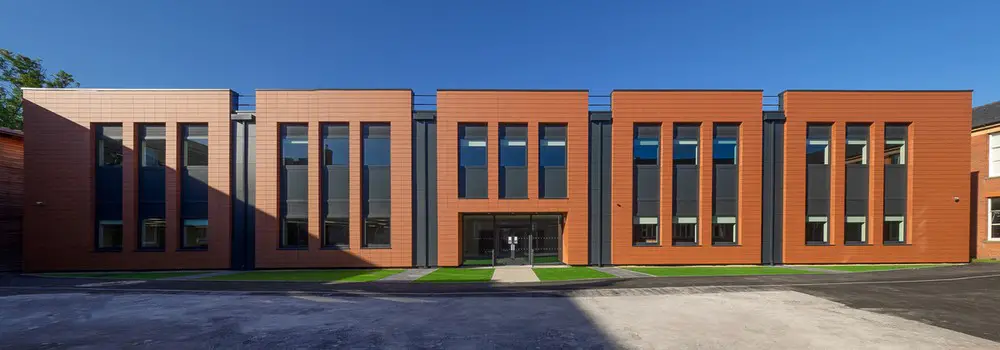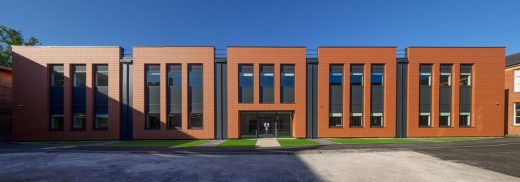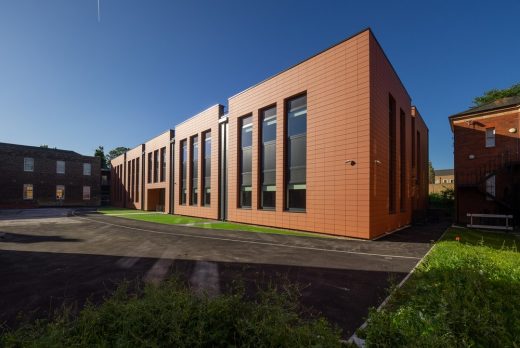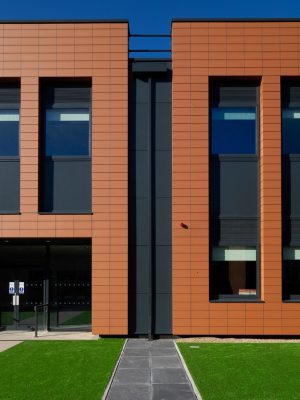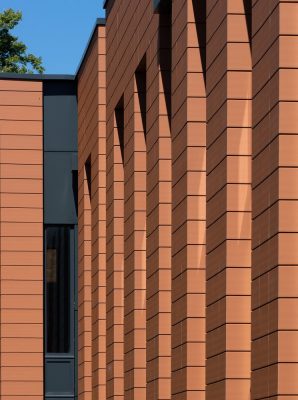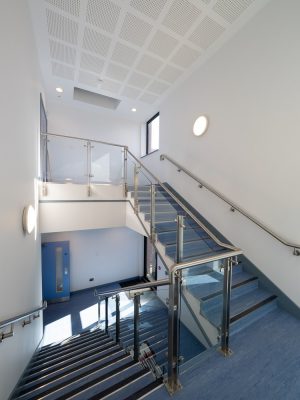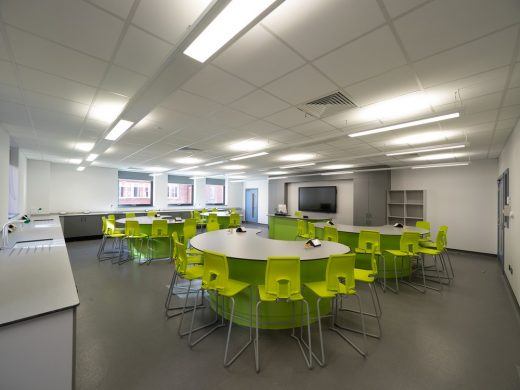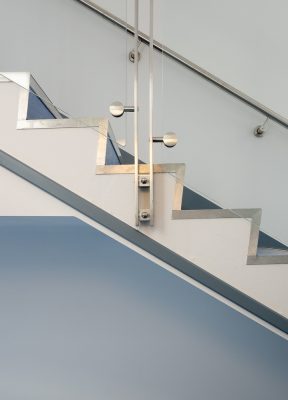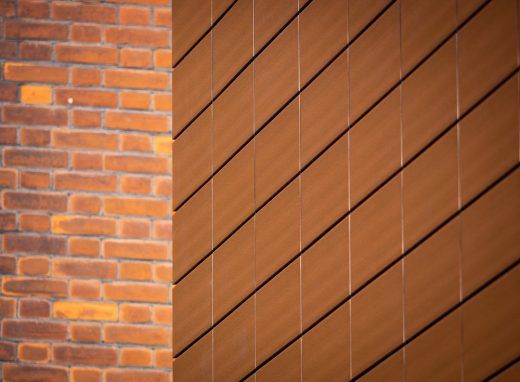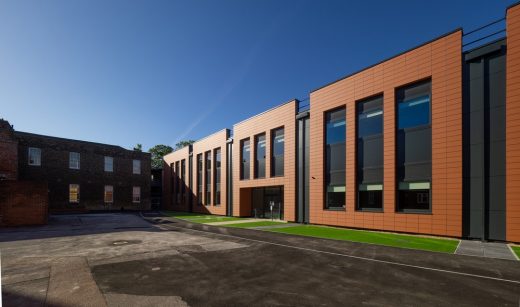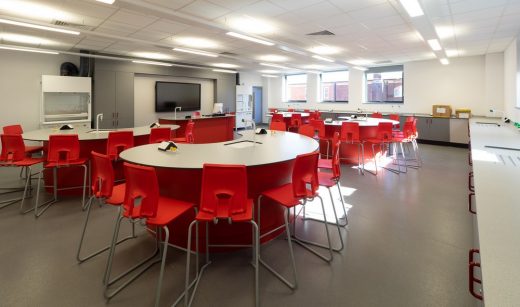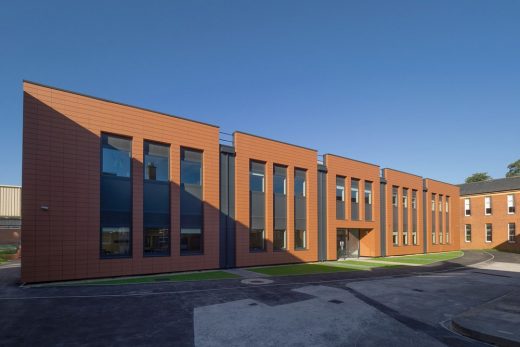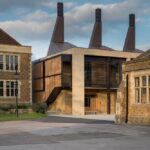Fort Pitt Grammar School Science Centre in Kent, Kent Property, Southeast England Architecture, UK Building Design
Fort Pitt Grammar School Science Centre
9 July 2020
Fort Pitt Grammar School Science Centre, Chatham
Architect: Hazle McCormack Young LLP
Location: Chatham, Kent, Southeast England, UK
A new state-of-the-art replacement science facility for a Girls’ Grammar School, comprising of 9 teaching laboratories with support spaces. The new Fort Pitt Grammar School Science Centre building has been delivered on the same site as the first Nightingale Hospital, surrounded by Scheduled Ancient Monuments, on a site overlooking Chatham, Kent.
The provision of a new group of science teaching facilities and a new 6th Form suite.
As a Scheduled Ancient Monument and a site containing 2 Listed Buildings, with very restricted access to much of the site, Fort Pitt School had been extensively developed during the late 1950’s and 60’s. The challenge for HMY was to find the most suitable location creating least impact for a large building on the site.
Sitting in a very prominent position above the towns of Chatham and Rochester, and with significant above and below ground heritage assets including a network of subterranean tunnels and caverns from the original military fort on the site meant that there were few suitable locations for the new science centre that would support both the working of the school and respect the heritage of the site. A replacement of two existing 1960s structures in one building became the key to unlocking the site potential.
Throughout the duration of the project extensive archaeology survey and recording work was required to ensure that all prominent structures both above and below ground were either worked around or recorded in the national archives.
Access for the construction was particularly difficult to the site with the narrow road access network and within the site with the existing buildings and heritage remains. The whole site, being a Scheduled ancient monument with Archaeology both below ground and above ground.
A clear strategy for access to the chosen site was developed alongside the original brickwork Fort Bastion walls, including the removal of a 1960’s redundant bridge link between the school tower and the fort wall and great care was taken to design a suitable temporary site access road so as the heritage structures were not damaged or impacted by the works. Once complete the landscape was returned to its original form and finish with rolling grass banks up to the original bastion wall.
The structure of the building was developed in a manner using smaller sections of materials including the steel frame so that deliveries to the site could be made by small rigid bodied lorries rather than the larger vehicles which simply could not gain access through the local road network or around the school driveways.
Extensive options appraisals were carried out to find the most suitable location for the new building, looking at visibility from the wider community, impact of the building on the wider fort and school structures and the extensive below ground archaeology. Consulting with English Heritage and the Local Authority Conservation department many of the locations looked at were steeped in below ground archaeology including closed below ground caverns and tunnels making them unsuitable for any development from both a structural and conservation perspective.
The chosen final location for the building to the rear of the main school and heritage buildings enables a new internal secure courtyard to be formed with the other 3 sides of the courtyard bounded by the original heritage buildings from both the Crimean era (the original Nightingale hospital wing) and the later added Victorian Wings.
A simple linear plan was designed arranged over 2 stories with a central main entrance space designed to be used by the school for display purposes and wider industry engagement, a central lift, and a staircase at each end of the block. The Location of the main entrance was designed to continue a existing formal ‘axis’ from the existing school.
In order to facilitate the construction of the new science building and enable access for vehicles an old redundant and dilapidated concrete bridge link between the historic Fort Wall and the 1960’s school tower building was removed and the original brickwork of the boundary fort wall repaired sympathetically to the original brickwork.
Teaching spaces are located on the Northern side of the building facing internally over the existing school to take advantage of the consistent northern light allowing for large areas of glazing but reducing the amount of solar gain. Support spaces were all located on the Southern side of the building, providing wc facilities, staff rooms, prep rooms, and smaller computer facilities. In this way visual safeguarding and privacy was also provided from the large residential development behind the school. Extensive benchmarking visits and consultations were carried out with the School science department to understand their preferences for teaching methodology and how this would impact the ‘fit out’ and layout of the science rooms.
Building on England’s first Nightingale Hospital:
Located within the remains of Fort Pitt, Chatham and in a prominent position above the historic towns of Chatham and Rochester, Named after Prime Minister William Pitt, Fort Pitt was part of the defences overlooking the River Medway. Fort Clarence, Fort Amherst and the Great Lines were visible from Fort Pitt, the whole providing a defensive ring to protect Chatham Dockyard.
Fort Pitt was laid out with red-brick walls with a bastion at each corner, and was surrounded by a 15 feet (4.6 m) deep defensive trench. The original fort included a number of buildings now demolished, including a central tower, or keep, removed in 1910 to provide more hospital space; a large blockhouse designed to house 500 men and two outlying towers, one on each flank, named ‘Delce’ and ‘Gibraltar’. The blockhouse was demolished in the early 1930s.
Fort Pitt, built between 1805 and 1819 on the high ground of the boundary between Chatham and Rochester, Kent, as one of a series of defensive forts protecting Chatham Historic Dockyard from the perceived threat of overland attack by the French during the Napoleonic Wars.
Between these forts, particularly Fort Pitt and Fort Amherst, existed an expanse of space, its openness constituting ‘fields of fire’ which contributed to the defensive function. Known as the ‘Great Lines’, this site is now preserved as the ‘Great Lines Heritage Park’.
Following its initially dual defensive and medical purpose, the ‘Fort’ functioned solely as a hospital caring for invalided soldiers returning from the Napoleonic, then Crimean and Great Wars. Over approaching 100 years use as Fort Pitt hospital, the site saw additions, notably in 1847 a building for servicemen suffering mental illness (now, along with the remaining section of the early C19 Crimea building, grade 2 listed). with an asylum added in 1849. Prompted by Florence Nightingale, the first Army Medical School was founded there in 1860, then to move to Netley in Hampshire in 1863.
During 1854 and 1856 Queen Victoria and Prince Albert made several visits to the Military Hospital at Fort Pitt.
Following the end of the First World War, in 1929 the Site was purchased by Chatham Education Board and turned into a school.
The School was extended and developed significantly during the 1950’s and 60’s and the later 1960’s buildings are in reasonable condition and a good example of system-built schools from the 1960’s.
Most of the buildings from the recent past are generally prefabricated structures and are in poor condition particularly the Science accommodation to be replaced.
The form and appearance of the new science building sits comfortably between and compliments both the Listed Crimean Wing and the later Victorian West Wing, echoing the tones and proportions of the existing buildings in a modern way. The newly formed courtyard provides new secure external space for the school to utilise as informal social space whilst also providing visual security from the large residential development behind the school, preventing overlooking into the social space.
The building has also been designed for future expansion, to secure the future of the School, allowing a lightweight 3rd floor to be added on the roof, including allowances within the fire strategy (staircase widths etc) and within the structural frame.
As a large building the ability to provide such extensive and bespoke design at a project cost of less than £2500/m² including the complete internal fit out and significant archaeology works was a financial success.
The Building has been a success for the School, and the Science Dept. The Head Teacher, Nick Watkiss stating:
‘A build costing £4 million was always going to present challenges but I have been hugely impressed with the delivery of the construction as well as the fitting out.
Thank you for adhering to the high standards required in all aspects and for providing such an outstanding piece of architecture. Both staff and students are very excited at the prospect of working in this new facility with its state-of-the-art provision.’
Sustainability Features
The Building was designed using the FEES (Fabric Energy Efficiency Standards) with highly insulated external walls using rainscreen cladding, excellent levels of insulation throughout the roof, floors and glazing and is serviced using high efficiency Air Source Heat Pumps and Underfloor heating. High U-Values for the fabric (External Walls at a U-Value f 0.12W/m²K) along with sustainable ventilation system with heat recovery reducing the schools current reliance on fossil fuels, particularly the extensive use of oil for heating.
The design target was for the building to be constructed to an emissions rate of 25% better than Building Regulations current standards, which the building exceeded with an emissions rate of 11.8kg.CO/m² over 30% less that the Target Emissions rate.
The project also facilitated the integration of ecological improvements and enhancements on the wider site including the installation of numerous Bat and Bird boxes and a hibernaculum and native planting to previously tarmac finished and scrub land areas prior to the development.
Building Methods
Traditional building methods using a steel frame with precast concrete plank floors and a metal rib deck roof. The external wall comprises of a lightweight SFS infill system clad with terracotta rainscreen cladding chosen to reflect the orange brickwork of the adjacent heritage buildings in both colour and proportions.
Fort Pitt Grammar School Science Centre, Kent – Building Information
Architects: Hazle McCormack Young LLP
Project size: 1630 sqm
Site size: 58328 sqm
Project Budget: £4000000
Completion date: 2018
Building levels: 2
Key products used:
Terracotta Rainscreen & Trespa Cladding, Engineering Brickwork, Aluminium Double glazed curtain walling and windows, Bespoke Laboratory Furniture Fit out, Stainless Steel and Glass balustrades, Single Ply membrane roofs, Drywall Partitions, Acoustic Door sets.
Photography: James Galpin
Fort Pitt Grammar School Science Centre in Kent images / information received 090720
Location: Chatham, Kent, south east England, UK
Kent Buildings
Contemporary Kent Properties
Black House
Architect: AR Design Studio
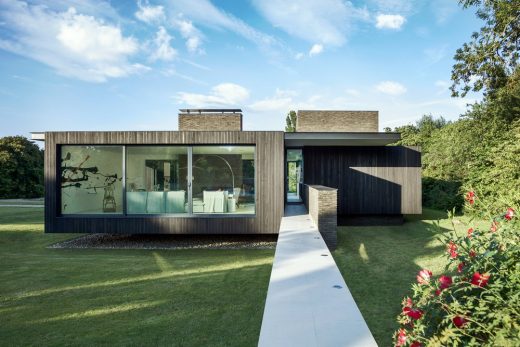
image courtesy of architects
Black House in Kent
Caring Wood, Leeds, Maidstone
Design: Macdonald Wright Architects
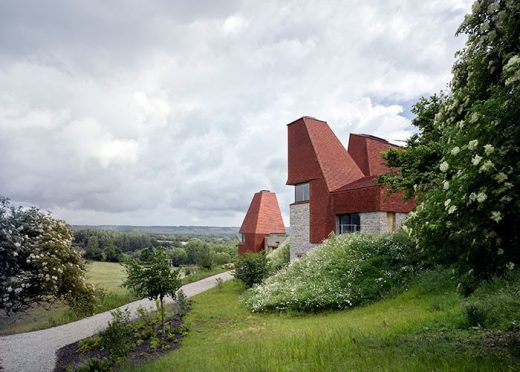
photo © James Morris
Caring Wood Residence in Kent
Contemporary Kent Architecture
Templeman Library
Architects: Penoyre & Prasad
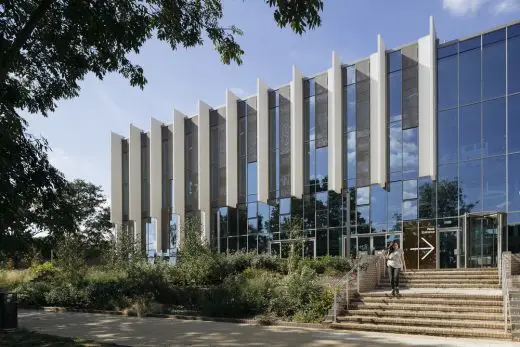
photo © Tim Crocker
Templeman Library in Canterbury
Curious Brewery
Architect: Guy Hollaway Architects

photo courtesy of architects
Curious Brewery Ashford Building
Fort Burgoyne in Dover
Design: Lee Evans Partnership, Architects
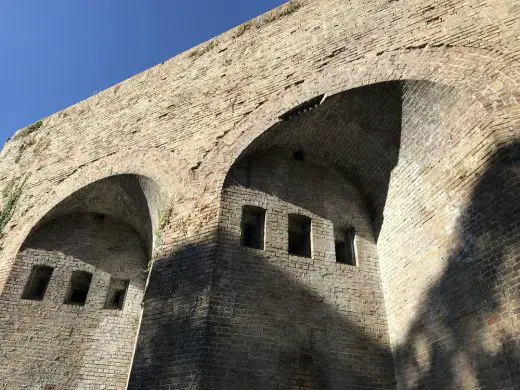
image from architects office
Fort Burgoyne in Dover
Comments / photos for Fort Pitt Grammar School Science Centre in Kent – Contemporary English Property page welcome
Website: Sevenoaks, Kent

